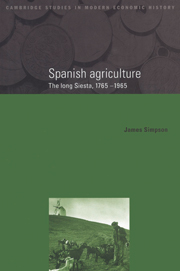Book contents
- Frontmatter
- Contents
- List of illustrations
- List of tables
- Acknowledgements
- Note on the regional division of Spain
- Abbreviations and conventions
- Introduction
- Part I The relative backwardness of Spanish agriculture
- Part II Traditional technologies and market opportunities, 1765–1880
- Part III The limits to technical change, 1880–1936
- 5 Soil fertility and the chemical revolution
- 6 Intensive cultivation and irrigation – a solution to low productivity?
- 7 The reluctance to mechanise
- Part IV Markets and institutions, 1880–1936
- Part V The State and the end of traditional agriculture
- Conclusion
- Appendix Estimates of agricultural output and consumption in nineteenth-century Spain
- Bibliography
- Index
5 - Soil fertility and the chemical revolution
Published online by Cambridge University Press: 04 December 2009
- Frontmatter
- Contents
- List of illustrations
- List of tables
- Acknowledgements
- Note on the regional division of Spain
- Abbreviations and conventions
- Introduction
- Part I The relative backwardness of Spanish agriculture
- Part II Traditional technologies and market opportunities, 1765–1880
- Part III The limits to technical change, 1880–1936
- 5 Soil fertility and the chemical revolution
- 6 Intensive cultivation and irrigation – a solution to low productivity?
- 7 The reluctance to mechanise
- Part IV Markets and institutions, 1880–1936
- Part V The State and the end of traditional agriculture
- Conclusion
- Appendix Estimates of agricultural output and consumption in nineteenth-century Spain
- Bibliography
- Index
Summary
In Part II we saw that Spanish farmers had tended to increase their output during the nineteenth century by shifting the frontier of cultivation. If improvements in welfare required higher labour productivity, there were strict limits to how far this could be achieved using traditional production systems, especially in a period of relatively fast population growth. Furthermore, by the late nineteenth century, the threat of cheap foreign cereals in domestic markets, the presence of new vegetable oils in export markets, and the widespread destruction of vineyards through disease (phylloxera) required new ideas and farming practices if farmers were to remain competitive.
In theory, there were two ways in which labour productivity might have been improved: by increasing the area cultivated per worker, or by increasing output per hectare, either through increased crop yields, or by changing the crop mix to higher value products. These two approaches are often illustrated by the historical experience of Japan and the United States between 1880 and 1930. Although both countries enjoyed significant growth rates in output per worker (1.85 and 1.02 percent a year respectively), the methods of obtaining the increase were very different. In the United States output per hectare grew relatively slowly, but the area of arable per male worker increased from 12 to 21 hectares between 1880 and 1930, an achievement made possible by the introduction of mechanical technology which reduced labour inputs, especially in cereal cultivation.
- Type
- Chapter
- Information
- Spanish AgricultureThe Long Siesta, 1765–1965, pp. 101 - 125Publisher: Cambridge University PressPrint publication year: 1996



